Thomas Berger once said, “The art and science of asking questions is the source of all knowledge.” As an entrepreneur, I’ve seen firsthand how true this is when it comes to connecting with diverse audiences. But here’s the reality—asking the right questions is just the starting point. How we ask them, and the language we use, is where the real power lies.
In my experience with market research, customer feedback, and even academic studies, I quickly realized that language barriers can be a major roadblock to gathering accurate insights. That’s where multilingual surveys come into play—they eliminate those barriers and ensure you’re collecting valuable, actionable feedback from every corner of the globe.
Creating these surveys, though, isn’t always straightforward. There are language nuances, cultural considerations, and technical challenges that need to be navigated. But that’s where the right survey tools make all the difference.
With the right solutions, you get robust translation support, seamless integrations, and an intuitive process for building multilingual surveys that truly connect with your audience.
If you’re ready to create seamless multilingual surveys that truly work for your business, let’s dig in and see how you can get it done right.
Source: Pexels
They offer easy-to-use tools, strong translation support, and smooth integration features, which makes it much easier to create multilingual surveys. This way, you can just reach out to audiences all around the globe.
Ready to take that step in creating your seamless multilingual surveys?
Let’s dig in.
What are Multilingual Surveys?
Participants can fill out questionnaires in the language they are most at ease with through multilingual surveys. These surveys help organizations gather accurate and diverse feedback from people worldwide by breaking down language barriers.
When translations flow smoothly and the phrasing fits the culture, it boosts response rates, enhances data quality, and makes multilingual surveys more inclusive.
Why Multilingual Surveys Matter
Surveys in different languages are excellent for connecting with a broader audience, fostering trust, and collecting more precise insights.
Multilingual surveys play a crucial role in so many fields. They help with market research by capturing what consumers worldwide think, assist international organizations in tackling challenges that cross borders, support academic studies that connect with different groups, and aid government initiatives in ensuring everyone’s voice is included.
Multilingual surveys serve a practical purpose; they help create an inclusive environment. This way, everyone gets a fair chance to join in and share their thoughts, regardless of their background or the language they use.
And now, let’s proceed to the features of the finest survey solutions you can find.
Benefits of Multilingual Surveys
In my experience, leveraging multilingual surveys has unlocked a whole new level of insight and engagement. Here are the key benefits that make them indispensable for any business:
Broader Reach, More Insights
By offering surveys in multiple languages, you immediately open up the possibility of gathering feedback from a wider audience. This expands your reach across different regions and cultures, ensuring you don’t miss out on valuable data from non-English speaking users.
Improved Response Rates
When users can take a survey in their preferred language, they’re far more likely to complete it. I’ve found that the ease of understanding increases engagement, leading to higher response rates and more reliable data. People are more willing to provide honest feedback when they feel comfortable doing so in their native language.
Accurate Feedback Across Borders
In my own projects, the biggest challenge with global surveys has always been ensuring the feedback was relevant and accurate. Multilingual surveys eliminate language as a barrier to accurate responses. Users can express themselves clearly, and their feedback becomes more actionable and insightful for decision-making.
Respecting Cultural Differences
Language is just one part of cultural differences. A well-designed multilingual survey goes beyond just translating words—it respects local customs, idioms, and preferences. This ensures that your surveys feel familiar and respectful to your diverse audience, making them more likely to respond honestly.
Faster Time to Market
Multilingual surveys allow you to gather insights from various markets in parallel, speeding up the research process. Instead of waiting for translation cycles or collecting data from one language group at a time, you can simultaneously analyze responses in multiple languages. This leads to faster, more informed decisions.
Better Product Development
Whether you’re testing a new app or gathering feedback on an existing product, multilingual surveys allow you to understand how different user groups feel about your offering. By collecting diverse feedback, you can pinpoint areas for improvement that might be unique to specific markets or languages, making your product truly global-ready.
Stronger Customer Relationships
In my experience, when customers see that you’re making an effort to communicate in their language, it builds trust. It shows that you value their input and are committed to delivering a better experience tailored to their needs. This strengthens customer loyalty and fosters long-term relationships.
Enhanced Brand Image
A multilingual survey demonstrates that you are an inclusive, globally-minded brand. It shows potential customers that you care about providing them with a seamless, user-friendly experience, which can significantly improve your brand perception across different markets.
Features of Top Survey Solutions for Multilingual Surveys
The success of a platform depends on user experience and efficiency. Leading survey platforms matter. With creativity and practicality, it handles linguistic issues.
Think of multilingual survey technologies that assist marketing goals. Marketing software systems are top-notch here.
Top survey software has culturally sensitive features. Marketing platforms often include email campaigns, CRM systems, and analytics tools. The best marketing software platforms create inclusive surveys and improve marketing.
The right tools make multilingual surveys easier. Leading survey solutions simplify the process with several features.
User-Friendly Interface
Isn’t it great to have an interface that is easy to navigate? You need not be a tech wizard to go through the form The design makes it super easy to create surveys and handle translations, so you can focus on putting together the questions that count.
Multi-Language Support
You have way more options than just a few languages. So, whether you’re dealing with the usual scripts or diving into something more intricate, like Arabic or Hebrew, that needs that right-to-left setup, this platform has your back.
Integrated Translation Tools
Another standout feature for you to consider is the integrated translation tool. You can go with the built-in options for quick translations, or if you need something more professional, you can connect with third-party services for extra help with languages. This flexibility ensures that your surveys are accurately translated and culturally appropriate.
Real-Time Collaboration
Collaboration becomes much easier with this feature. Your team can collaborate simultaneously, whether fine-tuning questions, going over translations, or adapting content for various regions. Say goodbye to endless emails and the hassle of version mix-ups.
Preview and Testing
Lastly, before you hit send, preview, and testing, features will allow you to see how your survey appears in each language. This lets you spot formatting problems, translation mix-ups, or design glitches before your audience sees them.
FREE. All Features. FOREVER!
Try our Forever FREE account with all premium features!
5 Best Software Solutions for Multilingual Surveys
Multilingual surveys require software with strong language support, seamless translation, and user-friendly interfaces. Here are the five best multilingual survey solutions:
- Qualaroo
Source: Qualaroo
Qualaroo helps organizations collect feedback and surveys from website visitors, app users, and customers. Its specialty is nudges, customized micro-surveys that appear as silent pop-ups on websites, mobile apps, and products.
Qualaroo also encourages multinational firms or those with worldwide clientele to ensure that feedback collection is translated into the audience’s primary or native language because nuances can make all the difference.
- QuestionPro
Source: QuestionPro
The comprehensive survey platform QuestionPro supports over 95 languages, including complicated character sets and right-to-left scripts. It supports manual uploads and automatic translation for precise localization. The software also offers extensive analytics and reporting options to filter replies by language for deeper study.
- SurveyMonkey
Source: SurveyMonkey
SurveyMonkey is a popular survey tool that covers over 60 languages for global research. It’s adjustable templates, and advanced question types enable customized surveys. The platform’s powerful reporting tools allow multilingual data analysis.
- Zoho Survey
Source: Zoho
Zoho Survey supports several languages and has sophisticated, multilingual capabilities. It improves data management and analysis with configurable survey templates and Zoho CRM integration. The platform’s sophisticated analytics tools let users acquire insights from multilingual surveys.
- LimeSurvey
Source: LimeSurvey
LimeSurvey, an open-source survey application, supports right-to-left and character-based languages. It lets you create multilingual surveys and let participants choose their language. The platform delivers tailored surveys, language question libraries, and respondent language filtering.
Steps to Create Seamless Multilingual Surveys Using Qualaroo
Surprisingly, Qualaroo has a straightforward method of creating a survey despite the many tools available online. It’s easier for you, and it allows you to customize as much as you can. Here, we present the following steps for creating a survey using Qualaroo. Let’s begin.
Step 1: Create Your Survey
Before you dive into translations, first ensure that your survey is created. Follow the survey creation guide in Qualaroo to design your survey.
Step 2: Click on ‘Add Translation’
Once your survey is ready, navigate to the “Add Translation” option.
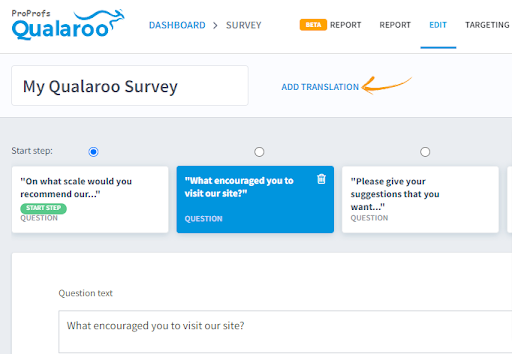
Step 3: Select the Language
Choose the language you want to add from the drop-down menu.
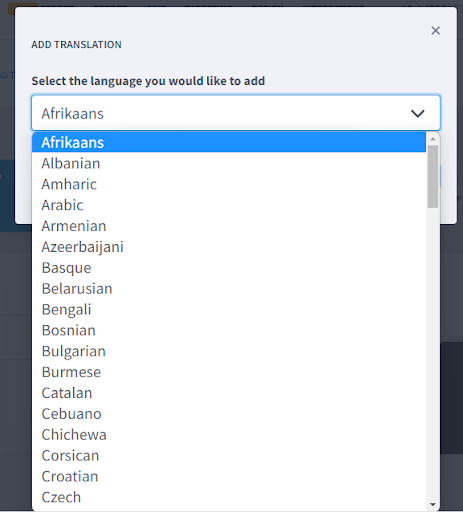
Step 4: Choose Your Translation Method
You have two options here:
- Automatically Translate: Let Qualaroo handle the translations automatically.
- Translate Manually: If you prefer to add custom translations, you can manually adjust the text for cultural nuances.
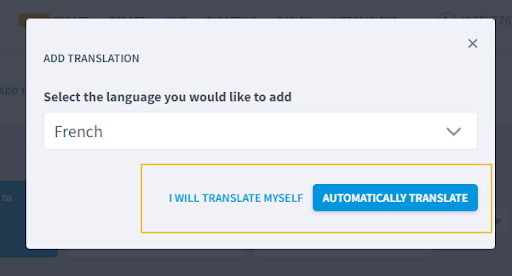
Step 5: Add Multiple Language Variations
You can add as many variations as necessary for your target audience. Qualaroo makes it easy to manage these language variations directly from the editor.
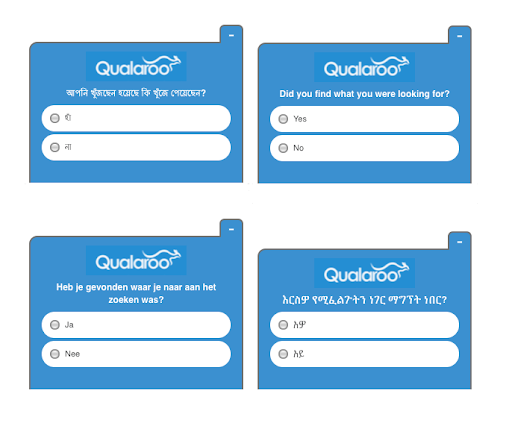
Step 6: Manage Language Translations
Once the translations are added, you can:
- Delete any language variation.
- Translate a specific survey screen.
- Retranslate the entire survey if needed.
- Language Detection
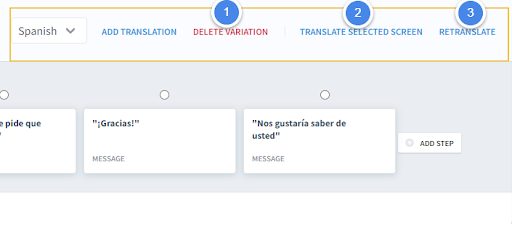
Step 7: Set a Default Language
If the browser’s language doesn’t match any of your translations, you can set a default primary language to show in the survey targeting tab.
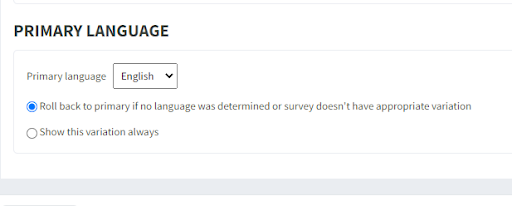
Step 8: Export Translated Responses
After collecting responses, you can export data from the translated surveys on a per-language basis.
- Go to the dashboard, click “More” and select “Export.”
- Or, access the reporting tab and choose the language you want to report on.
Step 9: Review & Adjust
After translating and exporting, review the data, making sure to adjust anything based on insights and feedback.
Step 10: Monitor the Results
To check the performance of your survey, go to the dashboard to see the real-time responses. Qualaroo has an AI-powered sentiment analysis where you can get insights from open-ended responses.
Break Language Barriers in Surveys With Ease
Multilingual surveys can be pretty straightforward and daunting. Using survey tools makes it easy to design, translate, test, and deploy forms that resonate with different audiences. When you embrace multilingual surveys, you’re not just being inclusive; you’re also gathering richer data and making a real impact across various cultures.
While creating them might seem complex, the right tools—like Qualaroo—can make the process smooth and seamless. Once you overcome the language barriers, you’re not only improving inclusivity but also gaining valuable insights that can drive smarter decisions and better customer relationships.
So, if you’re looking to get feedback from a global audience, now’s the time to take the plunge and make your surveys more accessible.
Source: Pexels
What are the research questions for multilingualism?
Research questions for multilingualism often explore cognitive, social, and cultural impacts, such as how multilingualism affects memory and problem-solving, how individuals switch between languages, and how it influences identity and integration. Additionally, studies may examine the role of multilingualism in education and language acquisition.
FREE. All Features. FOREVER!
Try our Forever FREE account with all premium features!
 We'd love your feedback!
We'd love your feedback! Thanks for your feedback!
Thanks for your feedback!






